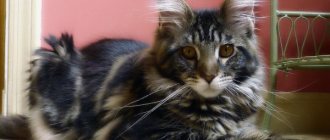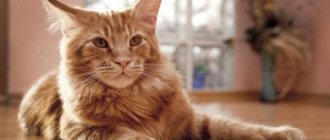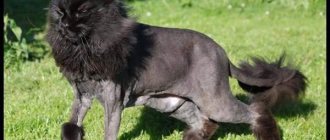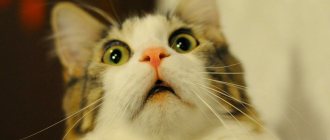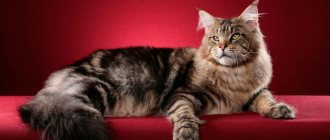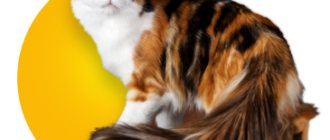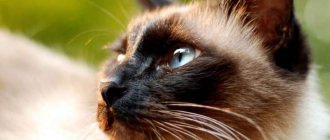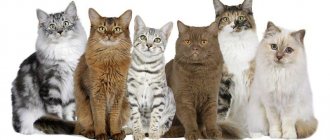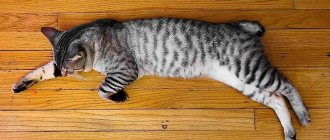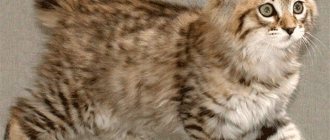The Maine Coon is a native cat breed that originated in the United States. Its development and formation took place mostly in Europe, where breeders and breeders developed new lines of animals, securing in them certain character traits and external characteristics inherent in modern Maine Coons. This led to the emergence of two intrabreed varieties: American and European.
American type
Maine Coons are the American type - classic representatives of the breed . Breeders from the USA strive to preserve their purebredness and original appearance, so individuals with similar external characteristics are selected for crossing. Aboriginal cats have a number of characteristic features that distinguish them from other cats when compared:
- strong bones;
- developed muscles;
- wide chest;
- small, high-set ears;
- Round eyes;
- long whiskers that helped cats in the wild navigate in the dark;
- wide head with a noticeable transition from a high convex forehead to a short muzzle.
Maine Coons have retained their beautiful bushy tail, which carries not only aesthetic beauty, but also practical benefits - many representatives of the breed sleep with their tail wrapped around them if they feel cool. The main difference between American-type cats is their thick, long and silky coat, which has water-repellent properties, which protects pets from bad weather. The Tabby color, characteristic in general for all Maine Coons, is more pronounced among the Aboriginals and has a clear pattern and contrasts.
There are also American Maine Coons of lilac, brown and rich chocolate color.
Food for Maine Coons
Many breeders wonder what to feed Maines. There are different opinions on this matter. Some say that animals should be fed only with special foods, for example, such as INNOVA, ACANA, ROYAL CANIN. Others prefer natural products.
Each owner decides for himself what to feed the animal. The main thing is that the food is of high quality and varied, since its health will depend on what the animal eats. It is imperative to take into account the age of the Maine Coon and its weight, since the amount of food must be strictly dosed. Kittens should not be overfed as this can be harmful to their health.
If the owner decides to feed the pet with specially developed food, he should give preference to high-quality products that were developed for large breed cats. More and more breeders give their preference to the ROYAL CANIN food line. This is due to the fact that the products in this series contain various vitamins and microelements that are necessary for the health of pets, fill them with energy, strengthen the immune system, make the coat shiny and beautiful and give it a healthy shine.
Another important point in feeding animals is the need to adhere to the feeding regime. Typically, food packaging contains detailed instructions. If the owner decides to feed the kitten only natural food, he should not forget that cats are predatory animals, which is why fish and meat must be present in their daily diet. Among meat products, it is best to give preference to beef, turkey, and chicken.
Kittens can also be fed raw meat. To do this, it is chopped into small pieces and then scalded with boiling water. When choosing fish, it is better to choose low-fat fish. It is given to kittens only in boiled form. In this case, it is advisable to remove all the bones so that the animal does not choke.
If a pet eats homemade food, it does not receive all the vitamins that are necessary for its growth and development. That is why you should supplement his diet with various vitamin preparations. In addition, cats happily eat porridge, cottage cheese, cheese, and vegetables, which can be mixed with meat products.
European look
The appearance of European Maine Coons in the 70s of the 20th century led to the formation of a separate type of representatives of this breed. European cats have significant differences from the aborigines - the work of breeders to consolidate certain traits in their pets provoked their distance from the original type and the manifestation of extreme traits. The goal of the breeders is to achieve maximum difference from the American type, this determines the main characteristics of the “Europeans”:
- long body;
- elongated, tapered muzzle;
- low forehead;
- long ears with tassels;
- high paws;
- long tail reaching to the shoulder.
An important difference between Maine Coons of the European type is their slanted eyes, the shape of which makes the look of these cats predatory and gives them a proud look. “Europeans” do not have such a thick and silky coat as the aborigines, but their beautiful solid smoky color makes them popular among cat lovers.
At the beginning of the selection breeds, “Europeans” were distinguished by fragility and excessive grace, but over time this problem was solved.
The character of the “American” and the “European”
Maine Coons are cats and dogs. Unlike other breeds, they love to spend time with their owner, bathe, and carry objects in their teeth.
Representatives of both branches, despite their attachment to the owner, value their independence. They love affection, but cannot stand intrusiveness. Constant squeezing is not for them. When guests come to the house, these cats can play, but they will not get into your hands.
Coons are quite active cats. They love to run and jump, so they require a separate play area in the house. Peak activity is morning and evening. They spend the day on the couch. American representatives of the breed love to play with balls and toy mice, as they are hunters by nature. “Europeans” love to lie on the sofa and have their tummy scratched.
Differences
Fans of the American Maine Coon type make every effort to preserve the natural qualities of the breed, while adherents of the “Europeans” strive to change the features of the traditional appearance of these cats and finally consolidate these changes.
The main differences between European-type cats and Aboriginal cats:
- longer body;
- elongated, almost triangular muzzle;
- oval, set far apart eyes;
- large, high-set ears, decorated with lush tassels;
- less voluminous coat, lack of a thick mane and lush “pants” on the paws;
- The color is most often a solid smoky color rather than a patterned tabby or agouti.
One look at the representatives of the European type makes it clear that these cats are decorative pets, reminiscent of a lynx, and not hunters - rat catchers, like the American Maine Coons.
Feeding Maine Coons
At first, you need to strictly follow the scheme specified by the breeder. Such a radical change of environment and getting used to the owners is already too much stress.
After a month or two, you can gradually introduce him to a different food.
Diet
The best meat is chicken or turkey; beef will also work, but not pork or lamb. Cats need offal products because they cannot synthesize vitamin A, and most of it is in the liver. Microelements and other useful substances are found in abundance in chicken heads, stomachs, and liver. You shouldn’t feed liver too often; too much of the vitamin is just as harmful as too little.
Another necessary food component for cats is taurine. It is found in meat, so they need it in sufficient quantities in their diet. Don't be afraid of high-quality dry food. Premium food contains all the substances a cat needs in optimal quantities and will only bring benefits.
In the medium-class feed, the composition is not selected so carefully, but in economy-class feed, the cheapest products are used, so their quality remains on the conscience of the manufacturer.
Maine Coons are the kind of cats that happily eat vegetables and porridge, especially if they have some meat or fish added to them. Are partial to bread. The more varied the diet, the better. Can't be fried, too fatty. Sweets are useless; cats’ bodies simply cannot digest them, but if you occasionally enjoy a cake, it won’t do any harm.
Hunting instinct
The Maine Coon breed, historically, living on farms, was adapted to catching and exterminating rodents. There they were specially bred as dexterous hunters. Large cats are mobile and adapted to any external environmental conditions. They are able to catch rodents at any time of the year in any weather.
Important! Modern Maine Coons, raised at home, have not lost their ability and passion for hunting. In any house or country house they will catch all the mice, they can also cope with rats.
Legends about the origin of the Maine Coon breed
As with many cat breeds, the early history of the breed is shrouded in mystery and legend. It is possible that in those early days, Maine Coons lived freely and got their name from their raccoon-like appearance and habits. Both are distinguished by long fur, and since tabby coloring is often found among outbred cats, the resemblance to a raccoon increases. Next is the area of legends that those same cats crossed with the North American lynx (a “strong argument” in favor of this version is the well-known delightful tufts on the ears of the Maine Coon), or even with a raccoon (part of the name “coon” is in favor of this version "- racoon in translation means "raccoon", as well as a wide fluffy tail and a color reminiscent of a raccoon). The versions are extremely romantic and attractive, but have no basis due to species differences and the impossibility of interspecific crossings. There are many legends about the origin of the Maine Coon breed from cats brought by sailors to the American continent. Some felinologists believe that raccoon cats are descended from Norwegian forest cats, which were brought to the American continent back in the 2nd century. Vikings. Others believe that Maine Coons were brought to North America from Asia Minor. Sailors took the ancestors of modern Maine Coons with them because of their excellent hunting instincts, as they were excellent catchers of rats and other rodents. Since there was always enough work for them in the holds of ships, these cats could well become permanent companions of humans on sea voyages. The state of Maine at that time was a large commercial center with intensively developing trade. From ships, cats could easily have reached the continent and spread throughout the state. There is written evidence that large ship rat-catching cats landed on the continent from sea ships during their stay. They also mention that sailors often, keeping a small kitten for themselves, gave the old cat on the shore into good hands.
Marie Antoinette One of the legends says that the American continent owes its long-haired cats to Marie Antoinette. During the French Revolution, the queen decided to flee France to America. Captain Samuel Cloa was preparing the escape of the disgraced queen. The ship was loaded with everything that the queen, a well-known fan of luxury, considered necessary to take with her on the trip: luxurious furniture, expensive trinkets and the queen's six beloved cats. But fate decreed otherwise. The escape failed, the queen was executed, and the captain was forced to flee for fear of persecution. This is how the cats of the disgraced queen found their way to the American continent, where they found their new home and were accepted into the society of short-haired cats that arrived on the continent earlier.
Another, but slightly less romantic version tells that there once lived an English captain nicknamed “Raccoon” (Kun), known for his adoration of cats and not setting sail without his purring retinue. His ship was inhabited by a huge number of expensive cats, primarily Persian and Angora. The captain made trips to the shores of America. People who received kittens from this ship, for obvious reasons, said “these kittens are from the Raccoon.”
There is another legend - about a cabin boy named Tom Kuhn, who served on Glen Lowry's ship. This ship stopped near Tarbox Farm in Maine, where a boy sold long-haired cats to farmers. He then sold several more cats on the same farm. The owner of the farm, Lida Choate, was breeding cats and became very interested in the powerful ship cats. They became the founders of the Maine raccoon cat breed. The first cats were named Yani and Jennifer. Numerous offspring were obtained from them; the word Choate (the breeder's surname) or Tarbox (the name of the farm) was added to the names of the kittens. Although there is no evidence that raccoon cats were introduced by Captain Coon (or a cabin boy of that name), Lida Choate cats became very famous in Maine. She may have been the first breeder of this breed and also gave the Maine Coon its name.
There is an opinion that Maine Coons were not brought to the American continent. The ancestors of this breed were large and massive aboriginal cats that were originally found in North America. These cats led a semi-wild lifestyle, for which they were perfectly adapted.
